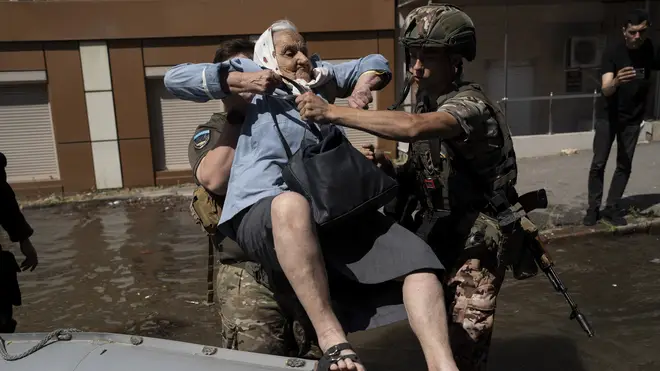
Nick Ferrari 7am - 10am
7 June 2023, 15:04

The Kakhovka hydroelectric dam and reservoir is essential for supplying drinking water and irrigation for a huge part of southern Ukraine.
Authorities have rushed supplies of drinking water to flooded areas after a major dam collapsed in southern Ukraine.
Officials are also looking into where they might resettle residents who relied on the breached reservoir on the Dnieper River, that forms part of the front line in the 15-month war with Russia.
More than 2,700 people have fled flooded areas on both the Russian and Ukrainian-controlled sides of the river, according to official tallies, but it is not clear whether the true scale of the disaster had emerged yet in an area that was home to more than 60,000 people.
The Kakhovka hydroelectric dam and reservoir, essential for supplying drinking water and irrigation to a huge area of southern Ukraine, lies in a part of the Kherson region occupied by Moscow’s forces for the past year.
It is also critical for water supplies to the Crimean Peninsula, which was illegally annexed by Russia in 2014.

Ukraine holds the western bank of the Dnieper, while Russia controls the eastern side, which is lower and more vulnerable to flooding.
Scenes of flooded communities, rescues and even people reportedly waiting for help on their roofs in some Russian-occupied areas called to mind a natural disaster, rather than one caused by war.
A day after the dam’s collapse, it remains unclear what caused it, with both sides blaming each other for the destruction.
Some experts said the collapse may have been due to wartime damage and neglect, although others argued that Russia might have had tactical military reasons to destroy the dam.

Many residents have fled the region due to the fighting, but others have stayed despite shelling and drone attacks, making it hard to determine how many people remain at risk in an area where hundreds of thousands lived before Russia’s February 2022 invasion.
Ukraine President Volodymyr Zelensky said he met with officials on the “urgent provision of drinking water and long-term solutions for settlements that were dependent on the reservoir”, as well as assessing damage to property and the environment in the region.
Flooding could wash away this season’s crops, while the depleted Kakhovka reservoir would deny adequate irrigation in the years ahead.
Russian terrorists have once again proved that they are a threat to everything living. The destruction of one of the largest water reservoirs in Ukraine is absolutely deliberate. At least 100 thousand people lived in these areas before the Russian invasion. At least tens of… pic.twitter.com/ISjIwKc2QN
— Володимир Зеленський (@ZelenskyyUa) June 7, 2023
Mr Zelensky accused Moscow-installed officials in occupied areas of failing to respond adequately to the emergency.
Russian-controlled authorities said they had evacuated fewer than 1,300 people in an area where as many as 40,000 people were said to be affected.
That compared with about 1,700 evacuated on the Ukrainian side where the population was reportedly around 42,000.

Residents of the Moscow-controlled village of Oleshky were reported to be stranded, according to the independent Russian news outlet Vyorstka.
It quoted one woman as saying that her mother, who could not make it to the roof, was in the water clutching a ladder. A volunteer said those awaiting evacuation included children and disabled people, it added.
Mr Zelensky said Ukraine will appeal to international organisations for help.
Civilians in Kherson clutched personal belongings as they waded through knee-deep water in the streets and rode rubber rafts.
Video on social media showed rescuers carrying people to safety, and what looked like the triangular roof of a building floating downstream.
The whole world knows about this Russian war crime, the crime of ecocide – the deliberate destruction of the dam and other structures of the Kakhovka hydroelectric power plant by the Russian occupiers. In fact, Russian terrorists have detonated an environmental bomb of mass… pic.twitter.com/knDtiekgID
— Володимир Зеленський (@ZelenskyyUa) June 7, 2023
Aerial footage showed flooded streets in the Russian-controlled city of Nova Kakhovska on the eastern side of the Dnieper, where Mayor Vladimir Leontyev said seven people were missing, although believed to be alive.
It is unclear how the dam disaster would affect the war just as Ukraine appeared to be preparing for a counter-offensive against Russian troops. Amid the disaster response, artillery boomed as people scrambled to leave the danger zone.
Addressing who might be to blame, the Institute for the Study of War (ISW), a Washington think tank, said Russia has “a greater and clearer interest in flooding the lower Dnieper despite the damage to their own prepared defensive positions”.

Amid speculation that Ukraine might have begun its long-anticipated counter-offensive, the ISW said Russian forces may think breaching the dam could cover a possible retreat and delay Ukraine’s push.
Experts noted that the 1950s-era dam, about 44 miles to the east of the city of Kherson, was believed to be in disrepair and vulnerable to collapse as water was already brimming over when the wall gave way. It had not been producing power since November, according to officials.
Both sides warned of environmental disaster from polluted waters, partly caused by oil leaking from the dam’s machinery. The empty reservoir could later deprive farmland of irrigation.
Officials from Russia and Ukraine, as well as the UN, have said that the damage will take days to assess, and warned of a long recovery period.